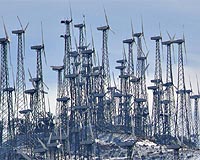 |
Berkeley CA (SPX) Dec 07, 2009 Over 30,000 megawatts of wind energy capacity are installed across the United States and an increasing number of communities are considering new wind power facilities. Given these developments, there is an urgent need to empirically investigate typical community concerns about wind energy and thereby provide stakeholders involved in the wind project siting process a common base of knowledge. A major new report released by the U.S. Department of Energy's (DOE) Lawrence Berkeley National Laboratory evaluates one of those concerns, and finds that proximity to wind energy facilities does not have a pervasive or widespread adverse effect on the property values of nearby homes. The new report, funded by the DOE, is based on site visits, data collection, and analysis of almost 7,500 single-family home sales, making it the most comprehensive and data-rich analysis to date on the potential impact of U.S. wind projects on residential property values. "Neither the view of wind energy facilities nor the distance of the home to those facilities was found to have any consistent, measurable, and significant effect on the selling prices of nearby homes," says report author Ben Hoen, a consultant to Berkeley Lab. "No matter how we looked at the data, the same result kept coming back - no evidence of widespread impacts." The team of researchers for the project collected data on homes situated within 10 miles of 24 existing wind facilities in nine different U.S. states; the closest home was 800 feet from a wind facility. Each home in the sample was visited to collect important on-site information such as whether wind turbines were visible from the home. The home sales used in the study occurred between 1996 and 2007, spanning the period prior to the announcement of each wind energy facility to well after its construction and full-scale operation. The conclusions of the study are drawn from eight different hedonic pricing models, as well as repeat sales and sales volume models. A hedonic model is a statistical analysis method used to estimate the impact of house characteristics on sales prices. None of the models uncovered conclusive statistical evidence of the existence of any widespread property value effects that might be present in communities surrounding wind energy facilities. "It took three years to collect all of the data and analyze more than 50 different statistical model specifications," says co-author and project manager Ryan Wiser of Berkeley Lab, "but without that amount of effort, we would not have been confident we were giving stakeholders the best information possible." "Though the analysis cannot dismiss the possibility that individual homes or small numbers of homes have been negatively impacted, it finds that if these impacts do exist, their frequency is too small to result in any widespread, statistically observable impact," he added. The analysis revealed that home sales prices are very sensitive to the overall quality of the scenic vista from a property, but that a view of a wind energy facility did not demonstrably impact sales prices. The Berkeley Lab researchers also did not find statistically observable differences in prices for homes located closer to wind facilities than those located further away, or for homes that sold after the announcement or construction of a wind energy facility when compared to those selling prior to announcement. Even for those homes located within a one-mile distance of a wind project, the researchers found no persuasive evidence of a property value impact. "Although studies that have investigated residential sales prices near conventional power plants, high voltage transmission lines, and roads have found some property value impacts," says co-author and San Diego State University Economics Department Chair Mark Thayer, "the same cannot be said for wind energy facilities, at least given our sample of transactions." Share This Article With Planet Earth
Related Links Berkeley Lab Wind Energy News at Wind Daily
 Wind projects don't affect property values
Wind projects don't affect property valuesBerkeley, Calif. (UPI) Dec 3, 2009 U.S. government scientists say they've found a home's proximity to wind energy facilities has no pervasive or widespread adverse effect on property values. Researchers from the U.S. Department of Energy's Lawrence Berkeley National Laboratory said their study was based on site visits, data collection and an analysis of nearly 7,500 single-family home sales. They said their research is the most comprehensive and data-rich analysis to date on the potential impact of U.S. wind projects on residential property values. ... read more |
|
| The content herein, unless otherwise known to be public domain, are Copyright 1995-2009 - SpaceDaily. AFP and UPI Wire Stories are copyright Agence France-Presse and United Press International. ESA Portal Reports are copyright European Space Agency. All NASA sourced material is public domain. Additional copyrights may apply in whole or part to other bona fide parties. Advertising does not imply endorsement,agreement or approval of any opinions, statements or information provided by SpaceDaily on any Web page published or hosted by SpaceDaily. Privacy Statement |